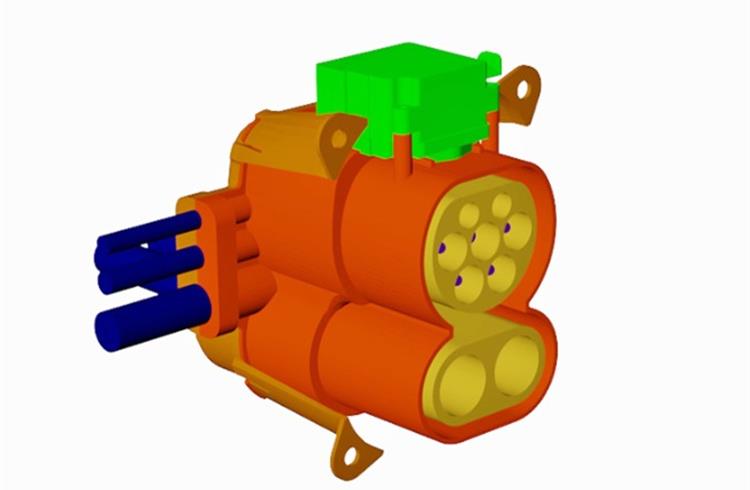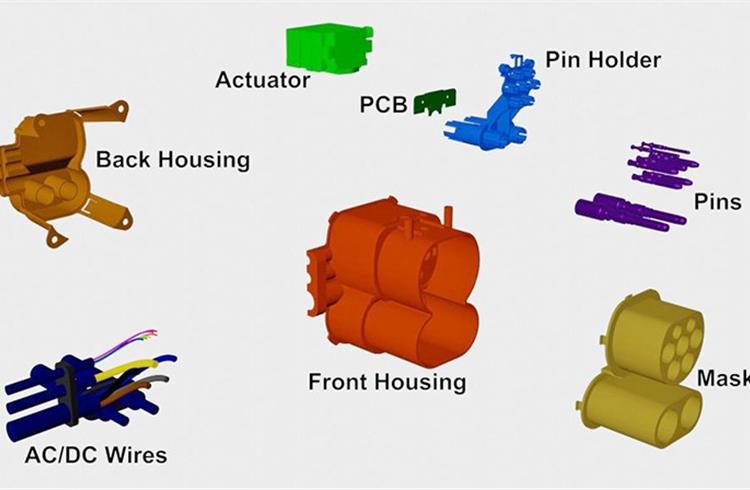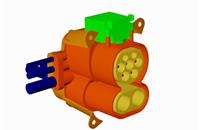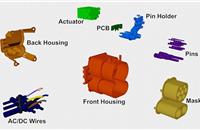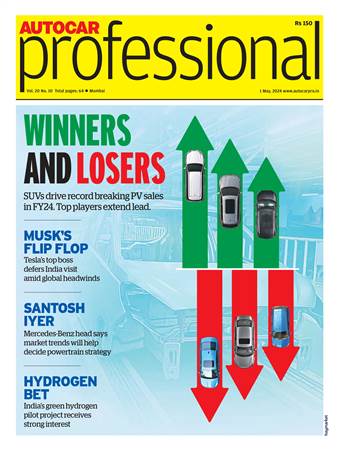Lanxess develops new design for EV charging inlets
Modular design based on customised material solutions; focus on material characteristics and optimised costs, screwless assembly with integrated fasteners, minimum components.
The boom in electric vehicles is causing a sharp rise in demand for plastics destined for charging infrastructure. Specialty chemicals major Lanxess believes this offers a wealth of opportunities to use its Durethan polyamides and Pocan polyesters.
The company has now used its thermoplastic compounds in a new design concept for EV charging inlets. These are installed in battery electric vehicles and accommodate the charging coupler of the external charging station.
“Our approach is aimed at using a modular configuration to get the right material in the right place to meet the complex requirements applicable to the various components with the utmost precision,” explains Gregor Jaschkewitz, application developer at the High Performance Materials (HPM) business unit, who devised the design. “At the same time, a high level of functional integration is intended to make it as easy as possible to assemble the entire unit, which means screwless assembly and minimal components in order to keep costs low.”
The design is the product of collaborative discussions with manufacturers of charging systems and incorporates the experience that Lanxess has already accumulated in numerous charging infrastructure development projects. “This means that it also satisfies a desire expressed by many manufacturers to have the ability to be as flexible as possible when it comes to charging inlet sealing,” says Jaschkewitz. O-rings, sealing cords or family seals can be used, for example, as can be employed lip seals manufactured in a two-component injection molding process.
Integrated thermal management
The key elements of this charging inlet design are the front and rear housings, a socket for the connector from the charging station and an actuator. The latter locks the connector in place to prevent it from being accidentally or deliberately pulled out during the charging process. The pin holder is another essential element. It holds the metallic connector pins in place, as well as a printed circuit board (PCB) with cables for charging with direct or alternating current, among others. Particular attention was paid to the design of the pin holder. It positions the cables such that the heat produced during charging is dissipated not only through them but also via the other cables not in use. “This means that the pin holder supports the thermal management and thus makes fast charging at high currents easier,” says Jaschkewitz.
Once the cables and contact pins have been placed in the holder and the PCB has been clipped in, all the charging inlet components are put together with the aid of snap fits. The cables are fastened in place under minimum strain so that they cannot become detached in the housing. Jaschkewitz: “The ability to join the components without the need for screws simplifies the assembly process and associated logistics, which, in turn, cuts manufacturing costs.”
Meets high material requirements
Plastics for charging inlets are required to comply with the IEC 62196-1 standard and deliver high electrical insulation resistance as well as high dielectric strength and tracking resistance. Good fire-retardant properties are also essential. Parts that come into direct contact with live components must pass a glow-wire end product test (GWEPT) in accordance with IEC 60695-2-11 at a glow-wire ignition temperature of 850deg C. After being stored at 80deg C for seven days, the plastic parts must not exhibit any surface changes – such as cracks – caused by aging.
High-grade mechanical properties (e.g. good toughness) are also required to ensure that the charging inlet is not susceptible to bumps or vandalism. “Our material solutions include compounds that are ideally suited to this range of requirements. In some cases, versions developed specifically for electric vehicles are also available,” says Sarah Luers, application developer at HPM.
“This includes, for example, highly weather- and UV-resistant products for housings as well as materials exhibiting low shrinkage and warpage for components that need to be particularly dimensionally stable. Thermally conductive polyamide 6 compounds with good mechanical properties are intended for use in the pin holder, which is subject to heavy thermal loads. This also includes product types that pass the UL 94 flammability test prescribed by the US Underwriters Laboratories Inc. testing institute with a V-0 rating.
Design for charging plug also in the works
Lanxess says it is currently considering applying the new design to further assemblies of the charging infrastructure – such as the charging plug. The design and materials expertise built up during work on the vehicle charging inlets can be deployed to a large extent here because the requirements are very similar.
RELATED ARTICLES
Bajaj Auto begins exporting Qute to Egypt, electric Qute in the works
Following a recent move by Egypt to formally recognize quadricycles as vehicles for public transportation and also to re...
Hyundai begins supplies of hydrogen fuel cell trucks in North America
Hyundai Motor Company, which has been actively working with partners to build a hydrogen value chain in North America, s...
ZF Foxconn Chassis Modules plots speedy growth with top tier customers
ZF Foxconn Chassis Modules, which supplies global premium and volume manufacturers and is represented at 25 locations wo...





 By Autocar Pro News Desk
By Autocar Pro News Desk
 23 Jun 2021
23 Jun 2021
 4830 Views
4830 Views



